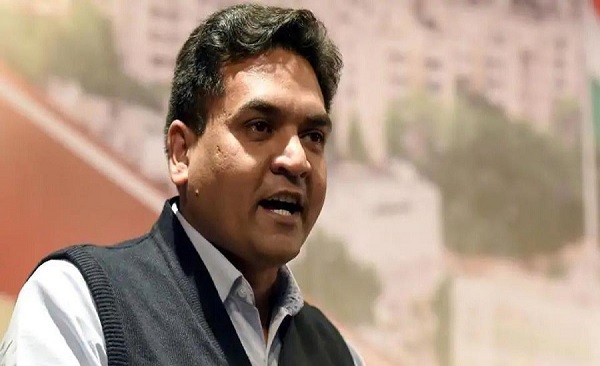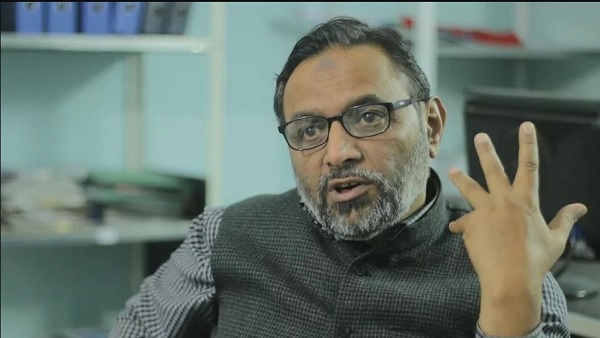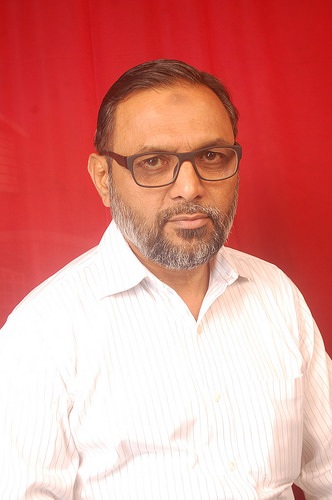
by admin | May 25, 2021 | News

BJP leader Kapil Mishra
‘Hindu Ecosystem’ led by the controversial BJP leaders ‘shows several levels of communal messaging mainly targeted against minorities
NEW DELHI – Communist Party of India-Marxist (CPM) leader Brinda Karat on Tuesday wrote to Delhi Police Commissioner demanding arrest of controversial Bharatiya Janata Party (BJP) leader Kapil Mishra after an investigative report revealed that he led an ecosystem which spreads hatred against Muslims, Sikhs and farmers of the country.
“We demand that you arrest Kapil Mishra for spreading enmity between different communities. His actions are anti- national and appropriate legal clauses should be invoked to take action against him,” reads the letter. The letter was written by Karat and CPM secretary of Delhi unit K.M. Tewari to S.N Shrivastva, Delhi Police Commissioner, referring to the arrest of Bangalore-based climate activist Disha Ravi in a toolkit case. They condemned Disha’s arrest saying that there was nothing seditious in Disha’s tootlkit. They said that on the contrary Disha’s toolkit called for unity.
On the other hand, the letter pointed out, Mishra’s group ‘Hindu Ecosystem’ “shows several levels of communal messaging mainly targeted against minorities.” “There are also numerous malicious fake news messages which seek to defame the farmers’ protests. There is also an attempt to link the anti-CAA protests with the farmers’ protests calling it “anti-Hindu”.
CPM targeted the Union Home Ministry under which the Delhi Police functions for showing leniency to Mishra and arresting a climate activist Disha.
Mishra, who has been accused of inciting Delhi’s anti-Muslim riots last year February, had shared the membership form of ‘Hindu Ecosystem’ on 16 November 2020 from his Twitter handle and appealed to his followers to join the group. Reporters at the portal Newslaundry infiltrated the group and exposed what was being done in the group.
“Thus we came to have a fly-on-the-wall view of how this ecosystem operates, how it creates propaganda material, how it comes up with toxic narratives, and how it manufactures trends across social media platforms to whip up communal hatred and bigotry, and, of course, support for Hindutva,” said the report.
There are 27,000 people who joined Mishra’s communal ecosystem; 15,000 joined its Telegram group; and 5,000 people joined its Twitter group. Most of the members of the group are from upper castes. They all work in a very organized manner to spread communal hatred against Muslims, Sikhs, Farmers and others. They share Islam and Muslim related unverified information. For example, they have shared lists of mosques located in various states which they claim has been built after demolishing temples. They also shared a way of spreading the same information by every member of the group on Twitter which helps in trending the information on social media. They also share fake claims and reports which show Hindus are in danger.
After protesting farmers clashed with the Delhi Police on the Republic Day, they shared information related to Sikh attributing it to terror activities. Posts were shared related to “Sikh terrorism”.
“If you don’t yet fully grasp the gravity of what’s being done through groups such as the Hindu Ecosystem, allow us to spell it out: they are fountains of misinformation, propaganda directed at hatred. They create and spread, in an organised way, Hindu supremacist and anti-minority bile, and incite communal hatred,” said the report.

by admin | May 25, 2021 | News

Dr.Qasim Rasool Ilyas
NEW DELHI – The Welfare Party of India (WPI) has strongly criticised the Delhi Police for naming the party’s national president, Dr SQR Ilyas, in their charge-sheet in connection with the February Delhi riots.
The party believes the police have done this with an intention to implicate Ilyas in the riots that rocked the north-eastern parts of the capital in February 2020.
In a statement, WPI national general secretary A.J. Siddiqui also raised strong objections at the shoddy investigations being carried out by the Delhi police, saying the investigating agencies had turned a blind eye toward the real culprits like Kapil Mishra, Mohan Singh Bisht, Jagdeesh Pradhan and others. Instead, they have named Ilyas and other innocent activists in the charge sheet, he said.
The charge-sheet claims that Ilyas had made a provocative statement. Rejecting the charge, Siddiqui said Ilyas was a prominent leader, a man of integrity and a patriot who strongly advocated unity in diversity.
Expressing dissatisfaction with the Delhi police which operate under the Union Home Minister, Siddiqui said those who had instigated and caused the violence in Delhi riots had not been arrested but innocent activists like Ilyas were being targeted whose only fault was that they exercised their constitutional right to dissent against the controversial Citizenship Amendment Act.
Siddiqui said the party would take a legal course of action and expose all those who were intentionally maligning Ilyas’s image and reputation. He called it travesty of justice for falsely implicating him and other innocent activists to silence dissent and to suit their political narrative.
Siddiqui demanded that the name of Ilyas, as well as those of all such innocent activists, be immediately dropped from the charge-sheet and all charges against them be withdrawn.

by admin | May 25, 2021 | News

Relatives mourn Mohammad Mudasir, 31, who was killed in rioting in Delhi.
Violence broke out after Kapil Mishra’s speech on 23 February, says Delhi Minorities Commission’s Fact-Finding report
- Delhi riots happened in an ‘organised and systematic pattern’. Muslim individuals as well as houses, shops, mosques and other properties belonging to Muslims were selectively attacked.
- The violence was not ‘spontaneous’ like a riot. Rather it was ‘planned and targeted’.
- Violence broke out shortly after Kapil Mishra’s speech on 23 February 2020 at Maujpur in which he openly called for forcefully removing the protestors at Jafrabad in North East Delhi. These threats were made in the presence of Deputy Commissioner of Police, Ved Prakash Surya.
- Muslim women particularly were targeted on the basis of their identity. Many women reported how in addition to physical violence their hijab and burqa were pulled off, and communal taunts and slurs were hurled at them.
- Muslim places of worship including 11 mosques, five madrasas, one shrine and one graveyard that were attacked and damaged in the violence. In many places copies of the Qur’an were deliberately burned.
- Police officers were mostly ‘mute spectators’ to the violence. Some victims recalled that police officers specifically refused to help saying there were ‘no orders from above’.
- Police officers are reported to have directly engaged in the violence in some places, and victims also reported instances where police encouraged or enabled rioters.
- Police delayed filing of FIRs, and where filed they were not acted upon. Many victims reported that police officers refused to register complaints that named the accused. In some cases police have even arrested the victims themselves.
NEW DELHI — The Delhi Minorities Commission (DMC) released on Thursday a fact-finding report on Delhi riots of February 2020. A 10-member fact-finding committee had been constituted by the DMC in March to look into the violence that took place in different areas of North East Delhi between February 23 and 27, 2020.
The Committee made efforts to invite victims of violence to come forward with information, documented individual victim testimonies at various sites of North East Delhi and conducted physical surveys of the damage to religious sites. The Committee also repeatedly sought information from the Delhi Police but did not get any response.

The Delhi Minorities Commission (DMC) members with the fact-finding report
Following are the key findings of the report:
Repeated Incitement to violence
Throughout the Delhi assembly elections from December-February, there were a number of speeches by BJP leaders inciting people to violence against anti-CAA protesters. The details of these speeches have been recorded at length in the report.
Violence broke out in different pockets in North East Delhi almost immediately after the short instigating speech of Kapil Mishra on February 23, 2020 at Maujpur in which he openly called for forcefully removing the protestors at Jafrabad in North East Delhi. These threats to the protesters and people, was given in the presence of Deputy Commissioner of Police Ved Prakash Surya.
Planned, organised and targeted violence
Armed mobs took to different areas of North East Delhi, attacked individuals, looted and burned property and businesses. The mobs where chanting and using slogans like, ‘Jai Shri Ram’, and even “Har Har Modi”, “Modiji, kaat do in Mullo ko”, “Aaj tumhe aazadi denge”, while they selectively attacked Muslim individuals, houses, shops, vehicles, mosques and other property. Testimonies recounted that the mob contained large number of outsiders but also included locals they could recognise. The mobs were armed with lathis, iron rods, tear gas shells, cylinders and firearms.
In several areas of North East Delhi, properties owned by Muslims were looted, burned, and completely destroyed. The attack was targeted to the extent that in instances, where the owners were Hindus but the property had been rented to Muslims, the building was not damaged but the moveable property was looted or burnt outside the premises.
Testimonies of the victims reveal that the violence was not spontaneous like a riot. It was planned, organised and targeted.
Targeting of Religious places
The report documents 11 mosques, five madrasas, one shrine and one graveyard that were attacked and damaged in the violence. Mobs specifically vandalised and burned Muslim places of worship, namely mosques and madrasas as well as religious symbols like copies of the Quran. Non-Muslim places of worship in Muslim majority areas remained untouched.
Large number of Muslims have been displaced from the area. Due to the national lockdown, Muslims were also displaced from the relief camps.
Role of Police
Multiple testimonies collected by this Committee recount reports of police inaction even as violence unfolded before them, or of police not arriving despite being called many times. Testimonies also suggest how the police were patrolling the area, but when asked for help, they refused saying they had no orders to act. Police also did not exercise powers to disperse unlawful assemblies, or take measures to apprehend, arrest and detain those perpetrating the violence.
Multiple testimonies of victims of violence have reported that FIRs have either been delayed or have not been acted upon. Further, in spite of the serious nature of complaints, the police did not act upon the FIRs filed. In some cases, police refused to register an FIR unless the complainant omitted names of the accused.
Testimonies also suggest that police were complicit and abetted the attacks. Even where police officials did attempt to act in order to disperse the crowd, victims state that the police stopped their colleagues as they attempted to disperse the crowd. (“do not stop them”). In some, they merely stood as onlookers while the mobs engaged in violence. In others, they explicitly gave a go-ahead to the perpetrators to continue with their rampage (“do what you want”). A few accounts state how the police and paramilitary officials even escorted the perpetrators safely out of the area, once the attack was over.
In some testimonies, clear allegations of engaging in direct violence, including physical assault and abuse, have been made against police officials.
In some cases, victims themselves have been arrested, especially where they filed or attempted to file complaints against named individuals. Muslim complainants are reluctant to visit police stations to pursue their complaints due to fear of being falsely implicated in cases.
Impact on Women
Testimonies suggest that Muslim women were attacked based on their religious identity; their hijabs and burqas were pulled off. Narratives of women suggest that the police and violent mobs attacked protest sites; women were beaten up by male police officers and attacked by mobs. Women have also recounted instances of acid attack and threats of sexual violence by the mobs.
The police used the chants of “Azaadi” to sexually harass women and attack them, including, at least one incident of a police officer flashing his genitals in front of women protesters. The nature of verbal abuses was also sexual and communal in nature. It is clear that the police did not come forward to help, and as stated, in several instances, resorted to violence towards women.
Compensation
The Fact-Finding Committee examined about 250 compensation applications taken from the documents available on the Delhi Government website. In addition, 450 Application forms given to the Committee were also analyzed. Where verification of the damaged site is complete, either a meagre interim payment has been made or in some cases, even that has not been done. There are cases where the verification process has not been completed yet.
Immediately after the violence, many victims had left Delhi. Due to this, many applications for compensation were not filed contemporaneously and neither were the FIRs lodged.
The Committee also found that there is a disparity in the amount being paid: Public officers who died in the violence have been paid Rs 1 Crore whereas the civilians/citizens who lost their lives have been paid only Rs 10 lakhs.
Despite the fact that law and order in Delhi comes within the control of the Central Government, the Committee found that there was no scheme or assistance by the Central Government to help the victims either by one time compensation or by extending any support in their rehabilitation process.
Recommendations
The report has recommended forming of a five-member independent Committee chaired by a retired High Court judge with a mandate to:
(i) Ensure the proper and prompt registration of FIRs in all cases where complaints have not yet been converted into FIRs;
(ii) Ensure the recording of victims’ statements under Section 164 of CrPC;
(iii) Ensure witness and victim protection in accordance with the Delhi Witness Protection Scheme;
(iv) Review charge-sheets filed by the police in light of left-out facts, to be submitted to the relevant court;
(v) Establish the full extent of the complicity and abdication of duty by the Delhi Police in allowing the violence to take place, including command responsibility, as well as culpability for engaging in direct acts of violence – including sexual violence – through a written report supported by photographs, videos and other evidence as possible, to be submitted to the court;
(vi) Ensure that compensation is paid to all victims in a fair and time-bound manner;
(vii) Review the Delhi government’s Assistance Scheme for victims to access whether the compensation amounts under each category are proportionate to the quantum of harm, injury, and loss suffered and provide new formulations, if any, in a written report.
The report has also recommended that the Delhi Minorities Commission should:
1. Appoint a team of 2-3 experts to assist the Claims Commissioner, on behalf of the aggrieved persons who may need assistance.
2. Establish a team of 5-10 experienced trial court advocates, competent in the practice of the criminal law, in collaboration with the Delhi State Legal Services Authority, to render legal services to the victims; ensure a gender balance in the team, and make sure special measures are taken to assist women and child victims, including for filing complaints of sexual violence against private persons and/or public officials. Assure women victims of effective legal representation, to pursue cases of sexual violence in accordance with their right to engage an advocate of their choice, to assist the prosecution.
3. Seek a legal opinion from a retired Supreme Court or High Court judge to assist the High Court in its determination on the direct and proximate nexus of the speeches and slogans raised by senior political leaders which led to breakout of violence.
For the Government of Delhi the report has recommended that they must:
1. Take special measures to ensure that no person who has exhibited a bias against any group is appointed as the Public Prosecutor in these cases.
2. Take all measures to ensure that Public Prosecutors act in a fair and impartial manner and in the interest of justice.
3. Use this report’s findings as the basis to determine and bear the cost of damages caused to religious places of worship.





